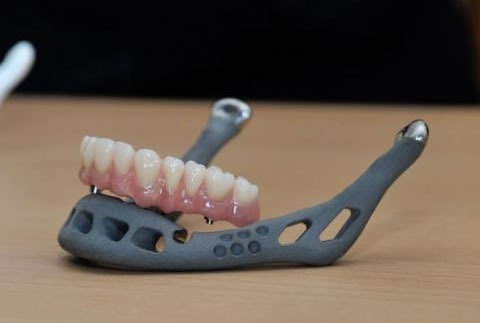In a medical breakthrough, doctors and bio-engineers have collaborated to bring the world its first lower jaw transplants, using a prosthetic jaw made by a 3D printer.
An 83-year-old Belgian woman underwent the operation last June, after suffering from an infection that rapidly ate away her jaw. In order to keep breathing, chewing, talking and feeling in her jaw, the patient had no option other than the complete removal of her mandible (lower jaw).
 Scientists at the University of Hasselt BIOMED Research Institute in Belgium developed a custom made implant using 3D printing of titanium powder. The design, processing and production of the implant were all done digitally, and the implant was ready in a few hours. Weighing 107 grams, the prosthetic jaw was just a bit heavier than a natural lower jaw, but to no disadvantage. The implant was coated with “artificial bone” and polished, fitting the patient perfectly.
Scientists at the University of Hasselt BIOMED Research Institute in Belgium developed a custom made implant using 3D printing of titanium powder. The design, processing and production of the implant were all done digitally, and the implant was ready in a few hours. Weighing 107 grams, the prosthetic jaw was just a bit heavier than a natural lower jaw, but to no disadvantage. The implant was coated with “artificial bone” and polished, fitting the patient perfectly.
The surgery restored not just the function but also the contour of the face in the patient. “Computer technology will cause a veritable revolution in the medical world. We just need to learn to work with it,” Dr. Jules Poukens, University professor and part of the development team, said in a written statement. “Doctors and engineers together around the design computer and the operation table: that's what we call being truly innovative.” He added, “Traditional surgery [of this kind\] takes up to 20 hours, and the patient should definitely stay two to four weeks in the hospital…But this operation lasted four hours and the woman could go home after four days.”
According to Xilloc Medical, the company that created the jaw, the day after the surgery the patient was already able to function normally with adequate speech, swallowing and movement. The patient needed antibiotics to heal properly after treatment.
“Once we received the 3D digital design, the part was split up automatically into 2D layers and then we sent those cross sections to the printing machine,” Ruben Wauthle, LayerWise's medical applications engineer, told the BBC. “It used a laser beam to melt successive thin layers of titanium powder together to build the part. This was repeated with each cross section melted to the previous layer. It took 33 layers to build 1mm of height, so you can imagine there were many thousand layers necessary to build this jawbone.” Once completed, the part was given a bioceramic coating. The team said the operation to attach it to the woman's face took four hours, a fifth of the time required for traditional reconstructive surgery.
The woman is currently gearing up to receive a set of dentures that will be attached to the implant in a follow-up procedure. A specially made dental bridge will then be attached to the part, following which false teeth will be screwed into the holes to provide a set of dentures.
“Shortly after waking up from the anesthetics the patient spoke a few words, and the day after the patient was able to swallow again,” said Dr Jules Poukens. “The new treatment is a world premiere because it concerns the first patient-specific implant in replacement of the entire lower jaw.”
The ground-breaking technology could be used in the future to replace other bones, researchers said. “The advantages are that the surgery time decreases because the implants perfectly fit the patients and hospitalization time also lowers - all reducing medical costs” said Wauthle. “You can build parts that you can't create using any other technique. For example you can print porous titanium structures which allow bone in-growth and allow a better fixation of the implant, giving it a longer lifetime,” he added.
The research follows a separate project at Washington State University last year in which engineers demonstrated how 3D-printer-created ceramic scaffolds could be used to promote the growth of new bone tissue. They said experiments on animals suggested the technique could be used in humans within the next couple of decades. LayerWise believes the two projects only hint at the scope of the potential medical uses for 3D printing.
However the ultimate goal was to print body organs ready for transplant, but Wauthle cautioned that such advances might be beyond our lifetimes. “There are still big biological and chemical issues to be solved,” he added.